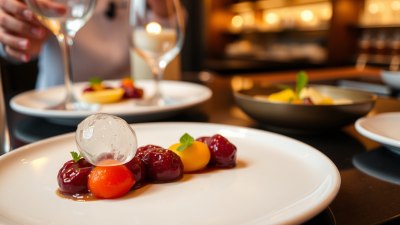Taste Without Texture in a Molecular Meal in Lima
Explore the innovative culinary world of molecular gastronomy in Lima, where taste transcends texture for an unforgettable dining experience.

Image created with Flux Schnell
Lima, the culinary capital of Peru, has recently embraced the realm of molecular gastronomy, elevating traditional dishes into extraordinary culinary experiences. This innovative approach is transforming how we perceive flavor and texture, challenging diners to rethink their relationships with food. In this article, we will delve into the concept of 'taste without texture,' examining how Lima's top chefs are redefining meals through molecular techniques.
The Essence of Molecular Gastronomy
Molecular gastronomy merges science and cooking, allowing chefs to manipulate the physical and chemical properties of ingredients. This technique enables the creation of new textures and flavors, making dining a multisensory experience. By utilizing methods such as spherification, foaming, and gelification, chefs can create dishes that surprise and tantalize the palate.
The Role of Peruvian Cuisine
Peruvian cuisine, known for its rich flavors and diverse ingredients, serves as a fertile ground for molecular gastronomy. Lima's unique culinary landscape, influenced by indigenous ingredients and traditions, allows chefs to innovate while honoring their roots. This blend of culture and experimentation offers diners a distinctive experience, where traditional dishes are reimagined with a modern twist.
Key Techniques in Molecular Gastronomy
Several key techniques are integral to the molecular gastronomy experience. Spherification, for instance, transforms liquids into delicate spheres that burst with flavor upon consumption. Foaming incorporates air into liquids, creating intense flavor experiences without the weight of cream or butter. Finally, gelification allows for the creation of unique textures, turning liquids into jelly-like forms that can be both savory and sweet. Each technique enhances the perception of taste, providing layers of flavor that dance on the palate.
The Interactive Dining Experience
Molecular meals in Lima are not just about eating but engaging with food in an interactive way. Chefs often encourage diners to participate in the cooking process, whether through assembling dishes or modifying flavors to suit their preferences. This level of interaction creates a memorable experience, allowing guests to form a personal connection with the meal.
Lima boasts several prominent establishments that specialize in molecular gastronomy. One such restaurant is Central, helmed by Chef Virgilio Martínez. Central emphasizes local ingredients and sustainability, offering diners a journey through Peru's diverse ecosystems. Each course is meticulously crafted, balancing taste and visual presentation while exploring the native biodiversity of the region.
Innovative Dishes to Try
At Central, guests can expect dishes like the 'Andean Potato,' which features spherified liquid potato served in combination with freeze-dried herbs and other flavor-enhancing components. This dish encapsulates the essence of Peruvian agriculture while using molecular techniques to subvert expectations about texture and taste.
Cultural Significance
Molecular gastronomy not only excites the taste buds but also engages the mind. Chefs like Pía León, co-owner of the acclaimed restaurant Kjolle, use molecular gastronomy to highlight Peru's culinary heritage while pushing the boundaries of traditional cooking. In her menu, León incorporates native ingredients with innovative techniques, presenting dishes that tell a story about the land and its people.
The Social Aspect of Culinary Innovation
Dining in Lima reflects a broader social trend where food becomes a medium for connection. Restaurants hosting molecular meal experiences allow guests to share conversations about flavor, culture, and creativity. As diners savor these avant-garde dishes, they engage in discussions about their culinary origins and the science behind the cooking methods.
Pairing Food and Drink
Incorporating molecular gastronomy into the dining experience also extends to beverage pairings. Mixologists in Lima have adopted molecular techniques to craft cocktails that enhance the flavor profiles of their culinary counterparts. These innovative drinks, often featuring smoking, emulsification, or innovative garnishes, tantalize taste buds while complementing the intricate dishes served.
Visiting Culinary Schools and Workshops
For those interested in deepening their understanding of molecular gastronomy, Lima offers culinary schools and workshops focused on this innovative approach. Aspiring chefs can learn from masters in the field, studying the science behind cooking techniques and how to implement them effectively. These educational opportunities contribute to the burgeoning interest in molecular gastronomy both in Peru and internationally.
The Future of Dining in Lima
As Lima continues to cultivate its reputation as a culinary hotspot, molecular gastronomy is poised to play a significant role in this journey. The intersection of tradition and innovation encourages growth and experimentation among chefs and diners alike. With each new dish crafted at the forefront of this culinary movement, we witness an evolution in the way food is perceived and experienced.
Molecular gastronomy in Lima has created an exciting landscape where taste transcends texture, offering diners a unique and interactive experience. As chefs push boundaries and explore the potential of food, we are reminded of the power that culinary innovation holds. The fusion of old and new suggests that the future of dining in Lima is not just about what we eat, but how we connect with food on all levels, from flavor to culture to memory.











